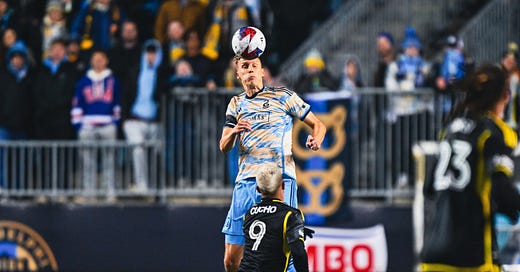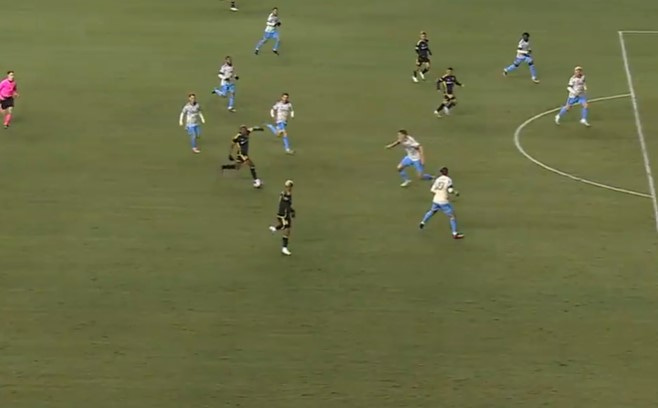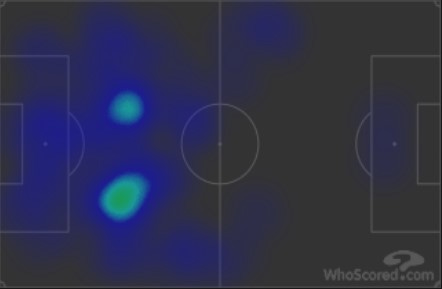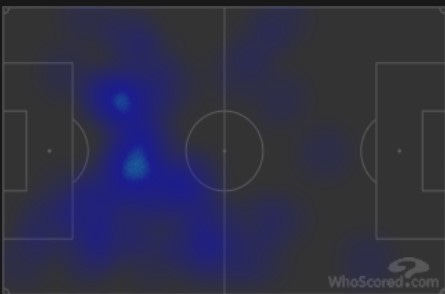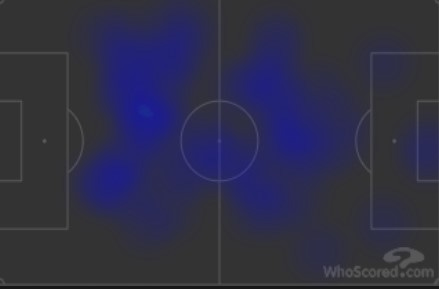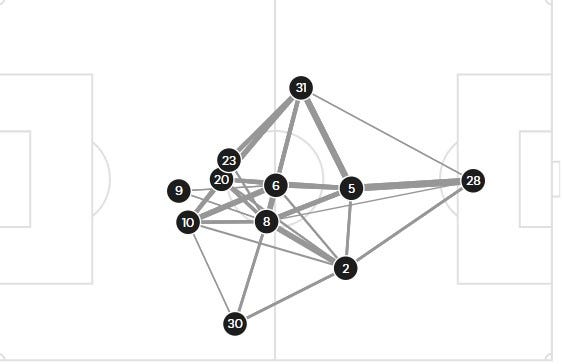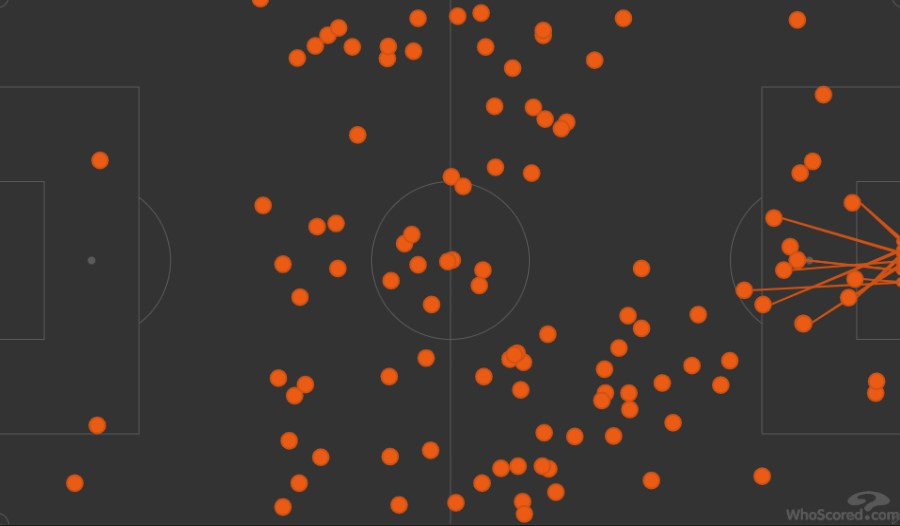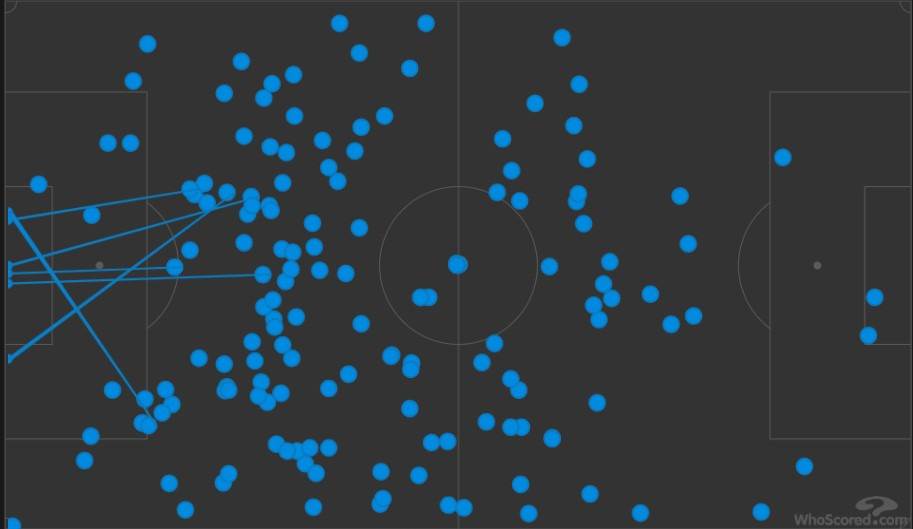Defensive Adjustment Helped Philadelphia Union Settle Into Rhythm Against Columbus Crew
A defensive adjustment from the Philadelphia Union's center backs helped change the direction of the game.
The Philadelphia Union left the field at Subaru Park with a 4-1 opening night win over the Columbus Crew.
But the Union were not dominant for 90 minutes. They faced some defensive struggles containing Columbus’ best players in the first 30 minutes of the contest.
Union center backs Jack Elliott and Jakob Glesnes adjusted to the positioning of Darlington Nagbe and Lucas Zelarayan. They played a higher line and smothered the opportunities both players had on the ball.
Columbus was allowed to play in space for the first part of the game, when it was the better team.
Nagbe was given acres of space before he played a pass to Cucho Hernandez in the build-up to the Columbus goal in the 28th minute.
Elliott’s line of confrontation was a few yards off the ball in this instance. Nagbe ran across the middle of the field with the ball before he played the pass to Cucho.
The Union were more than happy with Cucho taking a shot from the top-right edge of the box, but they were done in by a deflection off Glesnes that went past Andre Blake.
The entire sequence could have been halted, or at least made tougher to succeed, if pressure was put on Nagbe.
“Darlington is going to dictate the tempo of the game, no matter who he is playing against, no matter what minute it is,” Union head coach Jim Curtin said. “In between the 18s, I said there’s no better player at keeping possession. He’s hard to win the ball off of.”
“They had a lot of the ball and a lot of time,” Elliott said. “We were a bit deeper and letting them have it. I think when we started getting tighter to the guy on the ball side, and leaving the other guy 1v1, which we can deal with, it changed the game a lot.”
The adjustment from the center backs was to play a higher line and make Columbus’ two star midfielders feel the pressure once the ball was received.
Elliott and Glesnes played higher up the field, and as their heat maps suggest, they were well in front of their own penalty area. Elliott’s average position is on top. Glesnes’ is on the bottom. (via WhoScored).
“With us pressed up, it meant when they get the ball, there’s one or two players around them opposed to someone playing 1v1 with him in the open field, which is obviously tricky and can turn quickly,” Elliott said.
“I think that helped to make it difficult for (Zelarayan). Playing against two players all the time is going to be tough no matter how good you are,” Elliott said.
Zelarayan’s heat map shows that he barely entered the penalty area, and when he did, it was in some contained space on the left side. His average positioning matches with where Elliott and Glesnes ended up the most.
The same goes for Nagbe, who was limited to his normal spot in the center of the field.
Columbus’ ability to play game-changing passes stopped after the adjustment. You see how tight the Crew players were together on the passing network graphic from MLSSoccer.com.
Nagbe and Cucho combined to play four passes between each other, while Nagbe and Zelarayan had just 16 passes between them.
Nagbe completed 42 of his 47 attempted passes, per FBRef, but he only had one completed pass in the attacking third. The Crew produced 28 passes into the final third, but 13 of them came from center backs.
The Union also limited Nagbe’s forward passes. The Columbus midfielder had two progressive passes, which FBRef defines as completed passes that move the ball towards the opponent’s goal line at least 10 yards from its furthest point in the last six passes, or any completed pass into the penalty area.
Philadelphia’s goal against any central midfielder, whether it be Nagbe, Hector Herrera or anyone else, is to limit the passes a player makes in a forward direction. The Union have no problem with a Nagbe-type player passing the ball sideways, or by short lengths.
Twenty-three of Nagbe’s 47 attempted passes were between five and 15 yards. He attempted just two passes of 30 yards or more.
The Union were aware of how much space Columbus’ key players had in the opening stage, and they adjusted to it as well as a team could.
Julian Carranza, Daniel Gazdag and Mikael Uhre finished the 90 minutes with more activity in the penalty area (top) compared to Nagbe, Zelarayan and Cucho (bottom).
Zelarayan and Cucho took four shots in the first 30 minutes and then the Crew had a single shot as a team between the 40th and 75th minutes, when the Union did most of their attacking damage.
The adjustment allowed the Union to take over the game and leave with a dominant Week 1 score in their favor.
Photo courtesy of Philadelphia Union.
